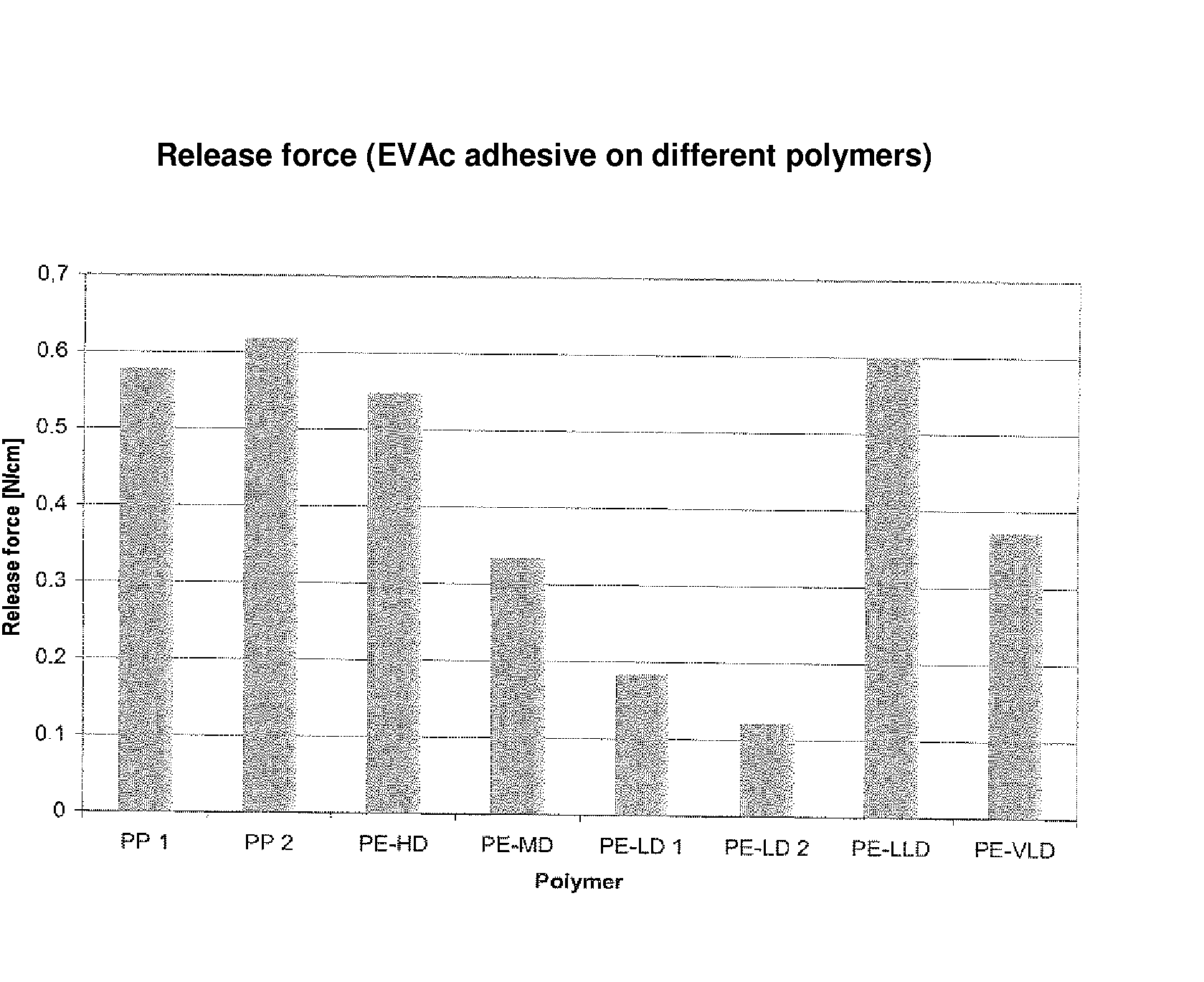Surface protection film with low unwind force
a protection film and low unwind force technology, applied in the direction of film/foil adhesive primer layers, film/foil adhesives, synthetic resin layered products, etc., can solve the problems of high bond strength of adhesive sheets, difficult to remove after use, and severe paint deformation of films described
- Summary
- Abstract
- Description
- Claims
- Application Information
AI Technical Summary
Benefits of technology
Problems solved by technology
Method used
Image
Examples
example 1
[0113]A film was manufactured by flat film extrusion in a width of 1450 mm. It was composed of a first layer 50 μm thick, an outer layer 10 μm thick and an adhesion promoter layer 10 μm thick on the free side of the first layer.
[0114]The composition of the first layer was the same as in Comparative Example 1.
[0115]The outer layer was composed of 100% (w / w) of Polyethylene LD252 (ExxonMobil Chemical, PE-LD, d=0.923 g / cm3).
[0116]Adhesion promoter layer and adhesive were the same as in Comparative Example 1.
[0117]The adhesive solution was applied to the film using a coating bar and was dried in a tunnel at 80° C. for four minutes. The protective film obtained was edged and wound into rolls 200 m long and 1400 mm wide. The application of adhesive amounted to 12 μm.
[0118]The self-adhesive film produced in this way was readily unwindable, without creases, and could be applied flawlessly when used to protect cars.
example 2
[0119]The protective film was produced by coextruding four layers, including adhesive.
[0120]Raw materials:[0121]First layer 50 μm:[0122]60% (w / w) Daplen FFC 2012 block copolymer (PCD, melt index 5 g / 10 min at 230° C. and 2.16 kg, ethylene content about 12% (w / w)),[0123]25% (w / w) Daplen KF 201 homopolymer (PCD, melt index 8 g / 10 min at 230° C. and 2.16 kg),[0124]6.3% (w / w) Lupolen 1840H (LDPE, Elenac GmbH, melt index 1.5 g / 10 min at 190° C. and 2.16 kg, density 0.919 g / cm3).[0125]8.4% (w / w) Titanium dioxide and[0126]0.3% (w / w) Tinuvin 770.[0127]Second layer 10 μm:[0128]100% Polyethylene LD165BW1 (ExxonMobil Chemical PE-LD, d=0.922 g / cm3).[0129]Adhesion promoter layer 10 μm:[0130]as Comparative Example 1[0131]Adhesive layer 12 μm:[0132]copolymer of 59.5% (w / w) vinyl acetate and 39.5% (w / w) ethylene having a melt index of 3 g / 10 min at 190° C. and 2.16 kg. Prior to extrusion, the raw adhesive material was processed into granular particles approximately 5 mm in size, with the addition o...
example 3
[0134]A film was manufactured by flat film extrusion in a width of 1450 mm. It was composed of a first layer 50 μm thick, an outer layer 10 μm thick and an adhesion promoter layer 10 μm thick on the free side of the first layer.
[0135]The composition of the first layer was the same as in Comparative Example 1.
[0136]The outer layer was composed of PE-LD and PP copolymer (85% (w / w) ExxonMobil Chemical LD252, density=0.923 g / cm3, 15% (w / w) Daplen FFC 2012 block copolymer).
[0137]Adhesion promoter layer and adhesive were the same as in Comparative Example 1.
[0138]The adhesive solution was applied to the film using a coating bar and was dried in a tunnel at 80° C. for four minutes. The protective film obtained was edged and wound into rolls 200 m long and 1400 mm wide. The application of adhesive amounted to 12 μm.
[0139]The self-adhesive film produced in this way was readily unwindable, without creases, and could be applied flawlessly when used to protect cars.
Comparison of Properties
[0140...
PUM
| Property | Measurement | Unit |
|---|---|---|
| density | aaaaa | aaaaa |
| density | aaaaa | aaaaa |
| thickness | aaaaa | aaaaa |
Abstract
Description
Claims
Application Information
 Login to View More
Login to View More - R&D
- Intellectual Property
- Life Sciences
- Materials
- Tech Scout
- Unparalleled Data Quality
- Higher Quality Content
- 60% Fewer Hallucinations
Browse by: Latest US Patents, China's latest patents, Technical Efficacy Thesaurus, Application Domain, Technology Topic, Popular Technical Reports.
© 2025 PatSnap. All rights reserved.Legal|Privacy policy|Modern Slavery Act Transparency Statement|Sitemap|About US| Contact US: help@patsnap.com


